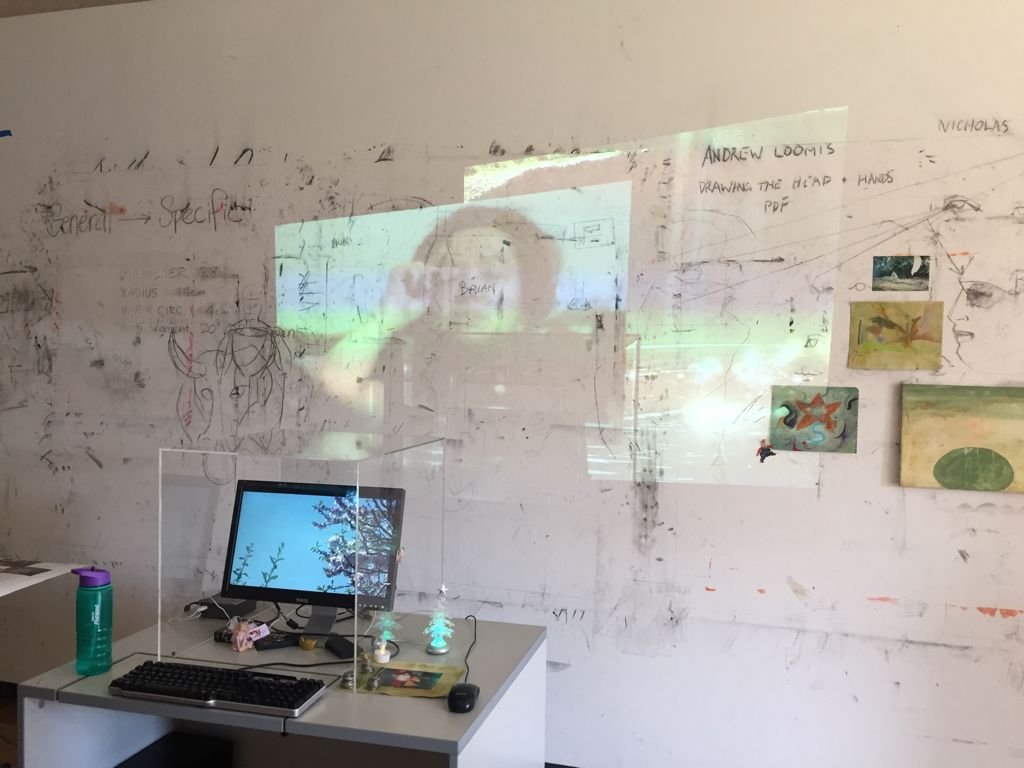Ja si mun (my name how my grandma said it), Multi-channel Video, Sound, Installation, Sculptural Assemblage, Collage, Painting, 2021
Adelaide Central School of Art BVA work
Within my studio practice in 2021, I made through an interventional, intimate and situational process. I recorded a lot of my everyday life circumstances, including car drives and conversations with family. I collected old family photos and sat with them. I collected objects I found inside and outside of my home.
My experiences growing up with technology and the projection of the media influenced the desire I had for ‘true’ connection, integrity and spirituality.
My processes acted to re-contextualise my boundaries for existing and express my own mental contradictions. My artworks expressed themselves in a humorous and cheeky tone. I collected, rearranged, played and brought attention to objects, sensations, colours and situations that saturated my life. I did this as a means to provide them a home with me, as they too had been perceived with a lost sense of purpose in an opinionated world.
Through merging and pushing contradictory things together, I wanted to question my proximity to the world and my proximity to the family members I lived with who grew up in a very different social and cultural circumstance.
The video documentation and conversations discussed centred heavily on labour, philosophical interpretation of ourselves in the 21st century here in Kaurna Yarta - informing the basis of what I do next.
The family collages are attempts to cradle the parents whom I love, who also need the care that they too provide. It is a recognition of working-class upbringing, diasporic reality and generational grief in the face of emotional distress.
Artist Statement
This stuff exists. It lives in my house. This stuff is on the street. It lives on the street. That person exists. (could I please touch you?)
And that person exists. (how much will I crave you??) hello. (my performative gestures confront my reality and act to recontextualise my boundaries for existing).
I play with things because I have nothing else to say except 'hello I am here!' Hello I am playing. Hello these boundaries don't really exist. What I do is absurd and cheeky because I miss my grandma.
Hello
Hello
hello
Eating a carrot
Saying hi to the weather
Longing to help my mum and dad and sister because in the past things haven't felt so emotionally stable.
When I play with the perceived boundaries of this or that and allow them to sit in contact with one another, there is no more room left for separation.
Photography : James Field (1-9) & Sam Roberts (10-14)
Videography and last four photographs : Artist
Process
The Everyday Essay excerpt
During the 1960’s the French philosopher Henri Lefebvre (1901-1991) sought to theorise ways in which to view daily life not simply as repetitious and tedious or seen in the literal sense, but to realise the deeper essence of daily life that is at play.[2] By formulating the everyday as its own topic of discourse; to pull it apart from its consistency, structure and linear place, to expose it and examine it and give it a history, critique can begin to form.[3]
An examination of the everyday is an examination on liveability and human autonomy in a world formulated on culture, politics and power structures that have been predetermined for us. Theorist Maurice Blanchot (1907-2003) states that society has been saturated in the everyday, yet simultaneously deprived of it.[4] By confronting plainly and openly that which is in front of me, all that is left is dissolution.
In 1968, writer Jean-Jacques Leveque (b. 1931) explained that what had formerly been known as a work of art, could now be described as a ‘living work’.[5] It is art that exists beyond simply its aesthetic principles but exists as a process which invites viewers into a stance of participation and human relations. Leveque claims that it is no longer about an exhibition, but it is about communication to the audience and how the artist’s actions are able to elicit viewers into a state of reflection: to know themselves better, dream better, love better and live without false pretences to any certain idea.[6]
The writers fight for human autonomy and advocate that everyday people are able to foster avenues for political stances within their daily lives and within the constructs of a designed system… Henri Certeau argues that individuals do not exist simply as passive consumers of their given environment, but that we create an understanding of what already exists in the world and use tactics to make do within a situational environment.[8]
All that I do within my practice could be described as ‘tactics’ as a means to reconcile my own internalised barriers. My aim is to show how everyone does have the power and capacity to live their desired life, free from control and mental barriers.
Reflection
Without stating the systemic oppression that disadvantages people, there will not be liberation for all. Without collective liberation and truth telling we will only step into an individualist dogma once again.
(15/07/24)
hiding my fries from you because I love you, 2021, McDonald’s food packaging, fries, photos
Windows, 2021, expanding foam, acrylic paint, door handle on canvas board
Domestic Connections, 2021, family photos, collage, family clock
Dick Family, 2021, acrylic on canvas paper, family photo
hard bread goes great with mismatched worldviews, 2021, red Chinese stools, white bread within installation, Ja si mun (my name how my grandma said it)


















